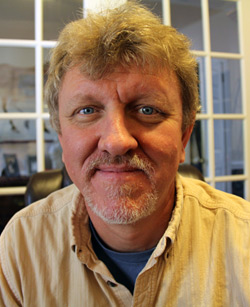 |
|
Dr. Ronald Kiene |
|
University of South Alabama marine sciences professor Dr. Ronald Kiene is part of a new five-year $4 million collaborative study focusing on the Gulf of Mexico and the Caribbean to uncover the causes of ciguatera fish poisoning, the most common form of algal-induced seafood poisoning in the world.
Ciguatoxins originate in certain single-celled marine algae called Gambierdiscus sp. that live attached to hard bottom structures such as coral reefs. The toxins are passed up the food chain, becoming concentrated in some fish. Although rarely fatal, ciguatera affects the digestive and nervous systems of people who eat the contaminated fish, causing severe symptoms such as nausea, vomiting or diarrhea that last up to six weeks.
This form of seafood poisoning is highly underreported but is estimated to affect more than 100,000 people annually. Its occurrence has been difficult to predict and manage. The research project could lead to better predictions of ciguatera outbreaks.
While this type of poisoning is more prevalent in the Caribbean, Kiene said the potential for outbreaks in other areas prompted NOAA to take a more regional approach, leading them to call upon the help of scientists along the Gulf of Mexico as well.
Joining Kiene on the NOAA-funded project is an international team of researchers led by Dr. Michael Parsons at Florida Gulf Coast University. The team includes scientists from the U.S. Food and Drug Administration Gulf Coast Seafood Laboratory on Dauphin Island, Ala.; Woods Hole Oceanographic Institution; University of Texas Marine Science Institute; University of the Virgin Islands; and University of Veracruz, Mexico.
Kiene said USA will focus on two aspects of the research. These include working with his graduate student Bradley Myer, a marine sciences major from Mobile, and Dr. Alison Robertson at the FDA Gulf Coast Seafood Laboratory to look at the distribution of ciguatoxins in the Gulf of Mexico and to identify biomarkers in fish that might indicate exposure to the toxin.
“The existing tests for ciguatoxin are very time consuming and as such are used only as a confirmatory tool after people have become sick from toxic fish,” Kiene explained. “Such biomarkers, if they could be identified, would be useful for screening fish quickly for potential toxin so people could avoid eating them.”
Kiene said the first fish included in the study will likely be grouper and barracuda collected in the Caribbean and northern Gulf of Mexico. This will include a comparative study of the fish, looking for ciguatoxin levels and specific proteins and small molecules that signal exposure to ciguatoxin.
“Ultimately, we are trying to develop a rapid screening test to find out if the fish has been exposed to the toxin, and if the toxin is at a level we should worry about.”
The second part of Kiene’s study will focus on field surveys in the Gulf of Mexico, where he and Robertson (FDA GCSL) will look at the distribution and toxicity of the algae. Together with his collaborators, they hope to determine triggers of growth and toxin production. One specific topic Kiene is interested in is studying how oxidative stress affects the production of ciguatoxin by the algae. Oil and gas rigs are among the primary places he will be looking.
“The type of algae that produce ciguatoxins are generally tropical (warm water) species that attach to the surfaces of corals and seaweeds, which is why it’s been more of a problem in the Caribbean,” Kiene explained. “But with the increase in surface water temperatures in recent years and growing number of structures in the Gulf of Mexico—both artificial reefs and oil and gas rigs—there is increasingly more potential for the algae to develop here.” He said factors such as global warming or continuing habitat shifts could potentially cause the algae to proliferate and become more of a problem for the Gulf of Mexico in the future.
According to Kiene, the biomarker study is the first step in this research with USA working in close collaboration with FDA researchers on Dauphin Island. He said the University will likely start field surveys in the second or third year of the grant.
The new study is funded through a national competition of the Ecology and Oceanography of Harmful Algal Blooms Program run by NOAA’s National Ocean Service/National Centers for Coastal Ocean Science.
To learn more about Kiene or USA’s department of marine sciences, visit
www.southalabama.edu/marinesciences. |

